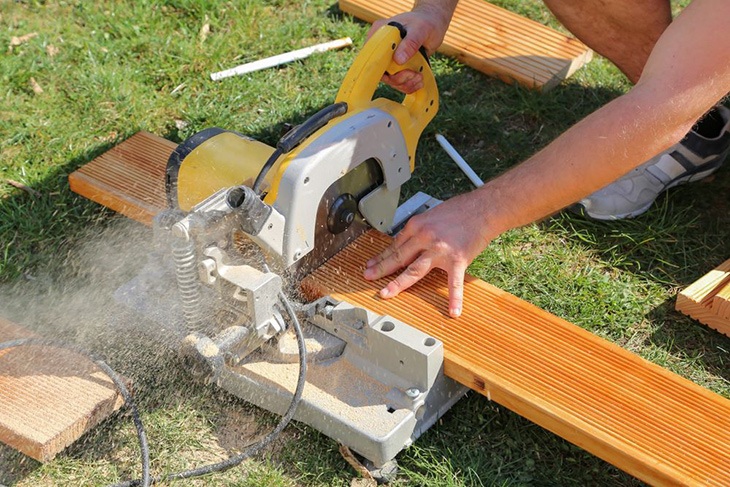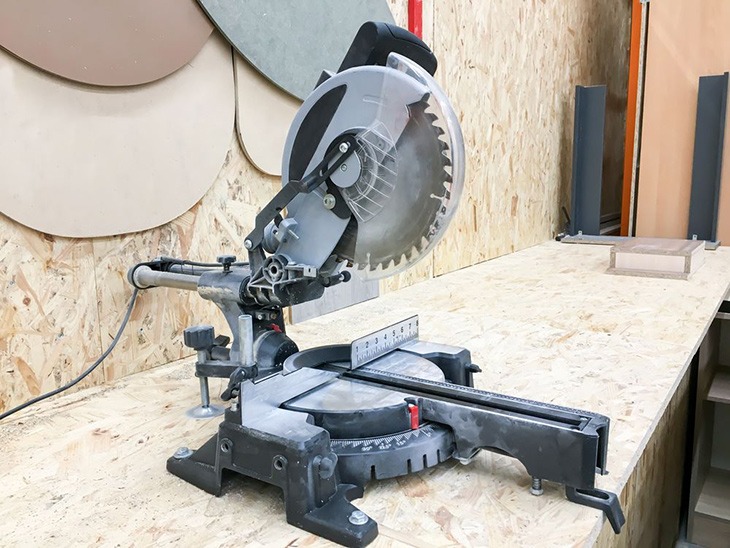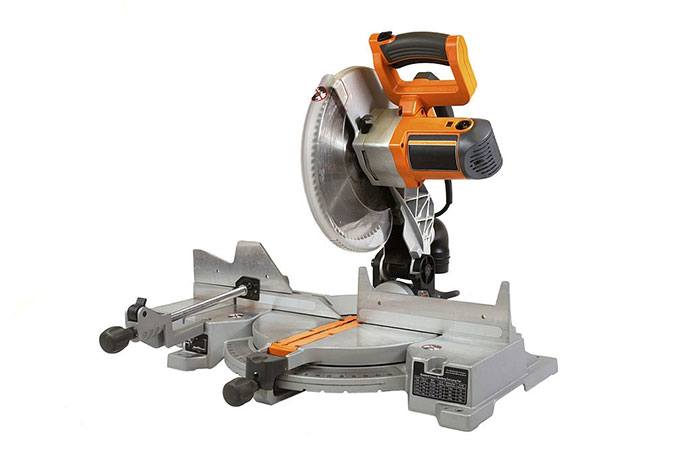Let's talk about the following scenario. You're starting a workshop, and you're looking to make a list of the necessary tools and accessories you'll need in your future endeavors. Naturally, smaller items such as hammers, nails, bolts, and boards are not your biggest concerns; it's the power tools you'll need to think about.
Most woodworking power tools cost a lot, and choosing one is an investment. So, you need a saw - which one?
That's what this article will be about. Two of the most used power saws in workshops are a chop saw and a miter saw, but which one will work better for you? All of us had the same problem when we started out since they are very similar, yet different in their own ways.
Accordingly, we've decided to make a "miter saw vs. chop saw" list as a way to clarify the pros and cons to both ourselves and you. We wish something like this was available when we first started out, so make sure to catch all the crucial points.
Let's go!
More...
General information: Overviews
If we're going to compare these two saws, we should obviously explain to you what they are and how they work before we get to the list, so let's dig in.
1. The chop saw
In technical terms, the chop saw is not really a saw per se. In most cases, the blade or the cutting wheel cuts wood and metal with high rotations using sharp teeth. The chop saw doesn't have any teeth or sharp edges, but it utilizes an abrasive disc, which is why it is most often addressed as an abrasive saw.
Abrasive chop saws are perfect for metal since abrasive discs are rough, durable, and they're really hard to break, which is why you'll rarely find a chop saw that's used for only wood cutting. Also, chop saws can't make bevel or miter cuts; they cut at a 90-degree angle, straight or crosscut.
Chop saws can be purchased in three forms: table tops, walk-behind, and free-hand models. They differ in segments such as power source, the materials they can cut, and design, but we'll get to that later on. Essentially, chop saws are your perfect power tools for metal cutting without much hardship.
The chop saw include parts such as

Blade: The blade type is in the form of an abrasive wheel. It is a regular circular blade, and it is not serrated. Most models of the Chop saw uses a 14-inch and above blade type.
Blade Guard: The blade guard is put in place to protect any user from direct contact with the spinning blade.
Base: This is a frame that supports the entire saw. It is small and made either with aluminum or steel material.
Blade lock button: It is a safety component that helps locks the blade tightly and prevents accidental spinning.
Vice and clamp handle: This secures the workpiece against the fence when cutting.
Motor: This is the Chop saw’s engine that provides the needed power for cutting through sturdy materials. Most models come with power around 15-amp.
Trigger Button switch: It is an on/off switch that helps to control the Chop saw and prevent accidental starting (safety switch) of the saw. It appears like a Trigger that can be used with four fingers hence reducing fatigue.
2. The miter saw
On the other hand, we have the miter saw, which has gone through many transformations from the moment the first model was invented. At first, you only had a backsaw stored at a miter box, but the surge of circular saws allowed some improvements on this particular power tool.
Nowadays, miter saws are much more versatile and come in various forms. Based on the tilt of the vertical axis and the direction it moves, you can choose among three main types of miter saws: single compound, double-bevel compound, and the sliding compound miter saw.
Since they're more delicate and have sharp edges, they're mostly used for cutting wood, unlike the chop saw with its thin grinding wheel. However, they have various sizes and designs which enable the user to perform various angled cuts and compound cuts, so you could say that the miter saw requires a bit more finesse and expertise.
The chop saw include parts such as

Blade: A typical blade of a miter saw is circular and is serrated all around with teeth. The blades are entirely small and downright precise. It is found in varying sizes of 7 ½, 8 ½, 10 and 12 inches.
Guard: Every power cutting tool/ saw often come with a guard for safety reasons. The blade guard of the miter saw covers the entire half of a blade from the top. The lower portion of the blade is attached to a hinge. The hinge allows the blade to open relatively to the extent of lowering.
Handle/Power Switch: This power switch is found on the saw’s handle. It allows for total control of the saw’s use. Its presence at the handle allows for quick accessibility in case of emergencies.
Fence: It is a flat, stable, and durable surface you can place your wood against when cutting.
Scale: The scale gives a direct measurement of the bevel cuts being made. It is usually built on the table of the saw. Scales could indicate common angles of 22.5 degrees, 45 degrees and 90 degrees.
Table: This is the base on which the actual saw is being placed. It also serves as a base for your workpiece.
Onboard Dust collector: For effective clean-up and to prevent clogging, common models of the miter saw it comes with an on-board dust collector system.
Motor: This is the engine of the miter saw, and it provides the power required for making effective cuts.
Miter saw vs. Chop saw: Detailed comparison and characteristics
The following paragraphs will deal with certain characteristics that are considered universal when it comes to saws, and we'll see how these two compare and, ultimately, which one's better.
1. Design
A common misconception arises when people talk about miter saws. They are often referred to as chop saws due to the similar appearance and general dimensions of both groups, which couldn't be farther from the truth.
They are very different tools that accomplish different cutting operations, which we're about to see. The design is the one to be blamed for this misconception, but there are some distinct things that separate these units that you can notice right away.
Miter saws have mounted blades that are connected to the circular saw that can be readjusted to be used at various angles. This type of design allows you to cut both crosscuts and miters, but it can also be positioned to make bevels if you readjust the vertical axis on a horizontal-laid table.
Also, power miter saws use specialized blades for cutting that have a large TPI number (teeth per inch) in order to make smooth and accurate cuts.
On the other hand, abrasive saws function in an entirely different way. Instead of the standard blade, the chop saw has abrasive blades or discs. Due to its rigid build and lack of configuration, a chop saw cannot make bevel or miter cuts, but it thrives in cutting 90-degree crosscuts with its grinding wheel.
You can easily differentiate between abrasive blades and miter blades when you look at their edges. Abrasive discs are thin, have no teeth, and they excel at cutting steel and tougher metals, which is the main difference between these two tools in essence - their use.
All in all, it really depends on your future plans as a woodworker or metalworker. A bulky, industrial design is perfect if you'll be working with tough materials, especially if there's a lot of debris around that could damage the tool. If you're a woodworker enthusiast, the miter saw will do you good.
2. Use

As you can guess, the major difference in the miter vs. chop saw battle is presented through their use.
Chop saws are bulkier and heavier, and their discs allow them to chop through metal with ease. These composite friction disks are often used in industrial works for two reasons - their resilience and size.
Abrasive discs are usually made with a 16-inch (410 mm) diameter or more in order to fit the needs of industrial projects. On the other hand, standard miter saw blades vary between 7-1/2-inch to 12-inch sizes.
Naturally, the difference in their sizes and strength allow them to cut through different materials in various ways. Miter saw blades are almost exclusive to wooden materials, but a larger blade can cut through a pipe or PVC. However, you shouldn't even try to cut through metal if you want to preserve your blade.
Overall, the miter saw is much more versatile since you can make various cuts - bevels, miters, compound, and straight cuts, based on its design. The flaw is that you can only work with wood. If we had to compare them in general terms, we'd have to say that the miter saw is the obvious choice in the long run.
3. Power source
The reason we want to focus on a subject such as a power source is due to the modern requirements of all power tools. Nowadays, more and more devices are cordless, which is natural due to the progression of batteries and their lifespan.
However, there are fewer and fewer chop saws on the market, which is why you won't be able to find a cordless model. They require a lot of energy since they're boosted tools that run on at least 120 Volts and operate at high speeds.
With this in mind, a stable and corded power source is always better, especially when you're cutting through steel.
On the other hand, miter saws require less power, which is why there's an abundance of cordless models out there. The full battery will give you around an hour or two of run time, depending on the model. Manufacturers such as DeWalt and Makita have excellent batteries in their 20V MAX collection that'll grant you excellent run times.
So, the benefit of having a cordless unit is obvious - there's no hassling with knots of cords, and you can maneuver quite easily with a cordless miter saw, especially if you're cutting at an awkward angle. On the other hand, you'll have to plan out your entire project to the minute so as not to lose power in the middle of cutting.
Still, we have to give an edge to miter saws since you can always charge up and continue with your work and the benefits are more than welcome.
4. Price
Comparing the prices of chop saws and miter saws is not so determined by the tools themselves since it almost always depends on the manufacturer and their prowess on the market. If we had to compare two mid-range miter and chop saws, the chop saw would certainly be a bit cheaper.
Then again, larger industrial-grade chop saws will be in the range between $300 and $500, which is way more than what you'd expect from a premium miter saw that's somewhere in the range between $250 and $300.
So, choosing the winner in terms of price is undoubtedly problematic due to variations in terms of packages, accessories, brands, and manufacturers, but both chop saws and miter saws can be found at a fair price, which is why we'd call this one a tie.
5. Power
So, power usually implies numerous things - the strength of the motor, the rotating speed of the blade (disc), and the time it takes you to cut through the material. Standard abrasive saws have a lower cutting speed than most miter saws, which is understandable given the difference in their cutting objects.
However, there are TCT abrasive saws: saws with tungsten-carbide blades that can cut straight to the core of steel and hard materials with ease. They are fast, strong, and make very precise cuts. Their cutting capacity is unmatched by miter saws and standard chop saws, but they're quite expensive, so there's that.
In terms of strength, the standard for these types of devices is a 15-amp motor, which is more than sufficient for delivering raw power to the blade or the disc. In essence, they are quite the same, but chop saws have a smaller edge in terms of power.
Below is a comparison table showing a summary of their differences.
Saw Type | Miter Saw | Chop Saw |
|---|---|---|
Blade | Serrated Carbide blades | Abrasive discs |
Blade Diameter | Blade sizes vary from 7- 12 inches | Not less than 14-inches |
Type of Cuts | Bevel, angular and cross cuts | Crosscuts |
Materials Cut | Thin aluminum, planks, plywood, and plastic | Tougher materials like Ferrous metals, and heavy-duty lumber. |
Ease of Use | Requires complex bevel setting | Too easy with only 90-degree crosscuts. |
Head-to-head battle: Pros and Cons
We hope that the previous paragraphs were enough to boil down some key differences between a chop saw and a miter saw.
Well, let's put it all together in a quick pros and cons list.
1. Miter saws
Pros
- Perfect for wood: The multi carbide-tipped blades and various adjustments of miter saws allow the user to fully manipulate a wooden material in a way that a chop saw never will.
- Versatility: Miter saw’s ability to cut wood is greatly owed to its adjustable head and rotating arm that can cut at various angles. This allows the user to make straight, miter, and bevel cuts, even cutting at compound angles.
- DIY projects: Even though you can use chop saws for different things other than construction projects, the miter saw is the one you’ll want for home projects. It’s easy to use and doesn’t require that much strength and skill.
- Ease of use: Not only will you master the miter saw in record times, but you’ll also be able to work freely without the constraints of cables and cords if you choose a cordless model.
Cons
- Application: Even though it’s quite versatile, the miter saw can only work with wood and some softer metals. Other than that, you’ll have to get a chop saw.
2. Chop saws
Pros
- Perfect for metal: If you need a bit more edge to your cuts, a chop (abrasive) saw is the way to go. The abrasive blade can cut through most metallic surfaces and non-ferrous metals.
- Affordable: Both metal chop saws and wood chop saws are highly affordable, even when they arrive from a premium facility.
- Straight cutting: A quality chop saw will give you straight, 90-degree cuts every time with complete accuracy.
Cons
- One-sided: Even though an abrasive blade is very useful to own, it’s generally considered to be one-sided, in the sense of being used strictly for metal and for one cutting application.
Frequently Asked Questions
Can I use a miter as a chop saw?
Not really; they are two different tools that cut at different angles. The outcome will not be what you expect.
Is a miter saw better than a chop saw?
Overall, a miter saw has more ways to be applied in the cutting business, which is why we would suggest purchasing a miter saw over a chop saw for beginners.
Can chop saws cut angles?
Nope, chop saws cut at 90-degree angles.
What would you use a chop saw for?
A chop saw is perfect for industrial work, such as cutting steel pipes and metals. On the other hand, miters are used primarily for wood.
Why is it called a chop saw?
Due to its chopping nature that wrecks every metal at a 90-degree angle, the abrasive saw is also called a chop saw.
Can miter saw cut metallic materials?
The metal type is what determines if a miter saw can cut metallic materials or not. But when using a miter saw, it is advised to use only for cutting thin metals like aluminum (although not ideal) and not heavy ferrous metals. Also, it shouldn’t be in large amounts.
How much can a 12-inch miter saw cut?
A 12-inch miter saw can cut lumber as wide as 7.5 inches and depth of 3.5-inches.
Is it suitable to use a chop saw for cutting wood?
Yes, it is suitable for cutting wood. However, it is quite a powerful tool for cutting soft materials like wood as this will result in clogging or dulling of the abrasive disc in the long run.
Conclusion
After diving deep into the characteristics and features of both miter and chop saws, we'd have to say that it's more sound to purchase a miter saw if you're looking for some more versatility for your projects.
On the other hand, if you know you'll be working with hard metals, the chop saw should be your go-to tool. That's it as far as the miter saw vs. chop saw battle is concerned.
